A blog to share informations and updates about Movie Industry... Thank you for reading my blog.......
Thursday, August 11, 2011
Sunday, July 3, 2011
Career Options in Animation
When one talks about a career in animation, the first ‘job’ that comes to the minds of most people is that of an animator. But that is just the tip of the iceberg!
One has to only look at the life-cycle of any animated project to realise how many different kinds of tasks or ‘jobs’ go into it. There are writers who create the concept and develop the story, there are people who specialize in writing scripts for animation, then there are the story-board artists who use pictures to tell the story and flesh out the plots and sub-plots. Then the character designers step-in to design the characters that inhabit the animated world besides artists who create inspirational sketches, backgrounds, colour themes and so on.
There are animators who actually ‘animate’ frame by frame. Depending on the technique they either draw by hand, directly on the computer, model or manipulate images. Within each technique of animation there are multiple tasks that need the expertise of different artists and technicians.
Computer animation, if 3D, requires modelers, riggers, animators, lighting/texturing artists besides programmers to tweak with the software and create custom scripts, plugins and special features.
In the case of stop-motion animation, there are the puppet/model makers, set designers, set-builders, cinematographers and so on.
There is also the critical element of audio – voiceover artists, singers, music composers are integral to the animation process.
Besides all these, there are the departments of production, admin, project planning, pipeline management, business development, marketing, distribution.
In VFX also, there are different kinds of roles to be played. Beginning at the most basic level cleaning up frames of footage to handling matte painting, rotoscoping, colour correction, motion control photography, digital compositing, wire removal, morphing, match moving etc.
Gaming can be broadly divided into 3 parts – game art, game programming and game testing.
Alternately, there is animation for the web – predominantly using Flash to create animation for website, portals, online marketing and promotion etc.
Broadcast also has a major requirement of animators and motion graphics specialists. Television channels whether news, music or film specific need in-house artists for show packaging, promos, bumpers, titles etc.
Besides all these, there is a lot of scope in animation education. With the kind of industry requirement for professionals, and institutes mushrooming in every nook and corner of cities as well as smaller towns, there is a dire need for skilled educators.
The latest in the long list of animation careers is something that is new and upcoming – animation journalism. Although not a formal branch of journalism, the animation boom in India has given birth to a new genre of writing and reviewing – whether it is through conventional print media, online channels or blogs. And we are proud to say that AAA is one of the pioneers in Indian animation journalism :)
Post taken from all about animation..
One has to only look at the life-cycle of any animated project to realise how many different kinds of tasks or ‘jobs’ go into it. There are writers who create the concept and develop the story, there are people who specialize in writing scripts for animation, then there are the story-board artists who use pictures to tell the story and flesh out the plots and sub-plots. Then the character designers step-in to design the characters that inhabit the animated world besides artists who create inspirational sketches, backgrounds, colour themes and so on.
There are animators who actually ‘animate’ frame by frame. Depending on the technique they either draw by hand, directly on the computer, model or manipulate images. Within each technique of animation there are multiple tasks that need the expertise of different artists and technicians.
Computer animation, if 3D, requires modelers, riggers, animators, lighting/texturing artists besides programmers to tweak with the software and create custom scripts, plugins and special features.
In the case of stop-motion animation, there are the puppet/model makers, set designers, set-builders, cinematographers and so on.
There is also the critical element of audio – voiceover artists, singers, music composers are integral to the animation process.
Besides all these, there are the departments of production, admin, project planning, pipeline management, business development, marketing, distribution.
In VFX also, there are different kinds of roles to be played. Beginning at the most basic level cleaning up frames of footage to handling matte painting, rotoscoping, colour correction, motion control photography, digital compositing, wire removal, morphing, match moving etc.
Gaming can be broadly divided into 3 parts – game art, game programming and game testing.
Alternately, there is animation for the web – predominantly using Flash to create animation for website, portals, online marketing and promotion etc.
Broadcast also has a major requirement of animators and motion graphics specialists. Television channels whether news, music or film specific need in-house artists for show packaging, promos, bumpers, titles etc.
Besides all these, there is a lot of scope in animation education. With the kind of industry requirement for professionals, and institutes mushrooming in every nook and corner of cities as well as smaller towns, there is a dire need for skilled educators.
The latest in the long list of animation careers is something that is new and upcoming – animation journalism. Although not a formal branch of journalism, the animation boom in India has given birth to a new genre of writing and reviewing – whether it is through conventional print media, online channels or blogs. And we are proud to say that AAA is one of the pioneers in Indian animation journalism :)
Post taken from all about animation..
Friday, June 17, 2011
The Animation Storyboard
The animation storyboard is the first sight of what a cartoon or piece of animation is going to look like. The animation storyboard looks like a series of strip comics, with individual drawings of storylines, scenes, characters and their emotions and other major parts of the movie. The drawings will reflect the early ideas of what characters will look like, what the backgrounds and scenery will be some idea of dialogue, emotions ,and a general feel of the animation process.
Storyboards are very important, as they form the basis of the work that is carried out on the movie, describing most of the major features as well as the plot and its development.
Animation storyboards are also the coordinating vehicle of the film, taking the place of the script, and allowing different teams of people to work on different aspects and scenes in the movie. A studio like Pixar will have thousands of storyboard frames like the one shown here.
The finished movie may not always conform to all aspects of the storyboard, but they will document many of the early developments in the movie. They are often the first step of the animation process, as they show the first views - albeit static - of the animation process.
Source : Internet
Motion Capture Technology
Motion capture technology is a good example of how digital techniques are being applied to the movie (and related) industries to allow more convincing visualizations of imaginary or composite images. For motion capture you use human actors who are dressed in a leotard with integral reflective or magnetic markers. The actor performs the actions that are required, and the digital cameras - or array of cameras - capture the motion of the reflective markers.
Computer Processing with Human Intervention
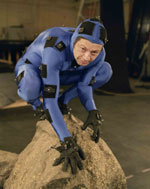 You subject the data to a computer process that converts this motion into a composite figure. You then modify this composite figure by normal computer animation software.
You subject the data to a computer process that converts this motion into a composite figure. You then modify this composite figure by normal computer animation software. The end product gives the effect of an animated character acting directly with human actors. Gollum, in the Lord of the Rings, was shot in this fashion, giving an absolutely life-like image of a composite character. That guy on the left here? That would be Gollum, or at least the movements of Gollum.
Motion capturing techniques are very effective, but the computer processing needs much human intervention, and if there is any error in the data, you can find it more effective to re-shoot the whole scene rather than correct the data. However, motion capture technology is so much more effective and realistic than traditional techniques, and ultimately less time consuming, that its future looks assured in movies and in video games.
Source : Internet
Thursday, June 16, 2011
Motion Capture Animation
Motion Capture Animation
Using Performance Capture or Motion Capture Technology to Enable Lifelike 3D Animation – Is it Acting or Animation?
With movies like James Cameron's Avatar pushing new boundaries of 3D animation, the concept of "performance capture" has come to the fore, addressing perhaps for the first time the issue of how to truly merge acting with animation. Unlike previous movies using motion capture technology, where facial movements still needed to be added in post-production by animators, performance capture allows every facial movement and nuance expressed by the actors to be conveyed by their virtual 3D selves.
Nothing is added in terms of facial movements in post-production, so actors are expected to emote fully on camera before the data is exported to their digital selves. The only additional animated movement required is for body parts that may not exist in reality, like tails on the Na'vi. And of course the animation of all the other fantasy creatures, worlds, textures, clothing and 'make-up' required by the story.
Actors themselves have struggled to some extent as to whether these fully or partially animated movies are really "acting" but there is no doubt in the minds of director Cameron and his cast that their acting skills are truly represented on the big screen in the form of the ten foot tall blue Na'vi.
With this level of innovation, the boundaries have been forever blurred between traditional animation, computerized 3D animation, high level special effects makeup and traditional movie making. For the actors, being able to replace hours in the make-up room having detailed makeup and expensive prosthetics applied on a daily basis, with live action footage in simulated green screen environments has got to be a huge step forward. And with the proliferation of screen actors taking key voice roles in animated movies in recent years, most acknowledge that 21st movie making is no longer all about the pretty face or perfect body.
James Cameron has been quoted as saying "I do think that there is an issue here where the acting community needs to be educated about what performance-capture really is, especially the way we did it on 'Avatar,' where we preserved every nuance of the performance."
Cameron has been working on the 'Battle Angel' project to make a live-action adaptation of the first three volumes of the manga series. Like Avatar, the movie will be a combination of live action and CG, with a female actor playing the lead character Alita and using the same performance capture technologies.
Director Robert Zemeckis also used performance capture for his movie Beowulf, starting Ray Winstone. Winstone makes the point perfectly that this technology is really just a post production version of hair and make-up. "What Ray Winstone said is the difference between this and live action is that in live action, you go into hair and makeup, you go into wardrobe, and then you act," says Beowulf producer Steve Starkey. "In this, you act, and then they put on your hair and makeup. There is no difference. You're acting in both, and I say it should be considered as a real performance."
Giant Studios
The creators of the proprietary performance capture technology used by Cameron for Avatar are LA based Giant Studios. Giant's proprietary technology is based upon advanced tracking and analysis algorithms, with a sophisticated suite of software tools that enable 3D animators to create high quality character animation faster and more easily than ever before. Giant's technology consists of hundreds of thousands of lines of code that define the human skeleton with scientifically accurate detail: bone length, density, connectivity, and rotation properties. All of which can be modified to mirror the appropriate skeletal set-up for any mechanism that needs to be animated.
With Giant Studios' technology, the result is organic, accurate animation of each character on screen. Due to the scientific accurate detail within the software, Giant defines specific bone lengths and motion parameters of each character skeleton being captured.
Because the software is robust enough to enable capture and processing of the motion data of multiple characters in one simultaneous process, the director can see in real time the live performance of the animated character, in a digital version of the set, with interactive camera and lighting controls. The director and producer walk away from the capture session knowing that they have the performances and the shots they need, avoiding expensive reshoots.
Motion tracking or motion capture started as a photogrammetric analysis tool in biomechanics research in the 1970s and 1980s, and expanded into education, training, sports and recently computer animation for television, cinema, and video games as the technology matured.
For anyone seeking a career in movie animation, becoming familiar with this rapidly evolving technology and understanding what part it has to play in moviemaking going forward, will be critical to your success.
Article written by Natcoll Design Technology,
Acting and Animation
"An animator is an actor with a pencil", goes the oldest and truest animation cliché. Not "a draftsman that acts", but first and foremost - an actor. If you're trying to tell a story through a character, inevitably you're an actor. The only question is whether you are a good actor or a bad one.
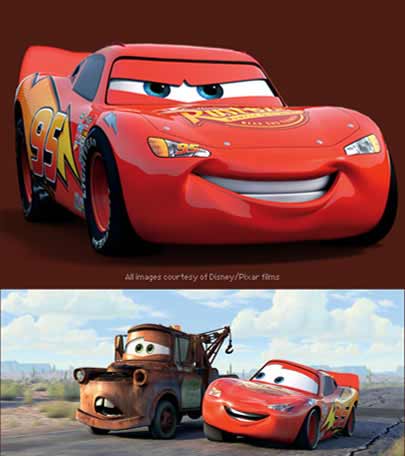 My feeling is that in the past few years, while there's been great progress technology-wise, the art of acting in animation has been abandoned. Compared with the acting quality of characters such as Shere-Khan (The Jungle Book), Captain Hook (Peter Pan) and others, today's characters are pale, dull, and lack personality. In better cases, an exceptionally interesting voice-talent saves the day (Robin Williams as the genie in Aladdin); but usually the script alone is responsible for providing the characters with some sort of personality.
My feeling is that in the past few years, while there's been great progress technology-wise, the art of acting in animation has been abandoned. Compared with the acting quality of characters such as Shere-Khan (The Jungle Book), Captain Hook (Peter Pan) and others, today's characters are pale, dull, and lack personality. In better cases, an exceptionally interesting voice-talent saves the day (Robin Williams as the genie in Aladdin); but usually the script alone is responsible for providing the characters with some sort of personality.
In the various internet forums one can find threads concerning software, design, textures - some even talk about movement - but it's rare to read something about acting. I haven't yet seen a comment saying something like "the animation is good, but the character has no personality". It seems that the level of expectations is so low, that it's enough for an animator not to make technical errors. Would you consider praising a writer simply because he made no spelling mistakes?
In the following article I have put on paper my thoughts considering acting in animation, which apply to any form of character animation - including 3D. The article is not meant to provide a "good acting in animation" formula - simply because such a formula does not exist. Every animator has his personal attitude, every film has needs of its own, and undoubtedly there are other ways of getting good acting. The goal is to propose a "toolbox" for the actor/animator, and maybe raise - even a little - the animators' awareness of acting in animation.
What is good acting?
When I ask my students what they think good acting is, the first answer is usually "believable acting". But credibility is only one side of the story. Good acting is believable and interesting. In my opinion, these two attributes wholly define good acting. With this idea as an axiom, we will try to separately analyze what makes acting believable, and what makes it interesting.
I. Believable acting
In the life of an animator there are short and rare moments of true magic. Those moments are the reason I became an animator, and they are the reason I still am one. I'm talking about a moment in which you look at the animation you've just created, and suddenly you believe your own character. Suddenly it's alive, it's there in its own right. Those are the moments of believable acting.
Believable acting holds a great power over the viewers, because the character they're watching gets a sort of meaning. Every man has meaning to us - even if we don't always think about it: If a total stranger sitting next to you on the bus suddenly collapses, you will not be indifferent - because the very fact that he is a flash and blood human earns him that meaning. This is why we feel sorry when Bambi's mother dies: we believe her and we believe Bambi, and both of them mean something to us. On the other hand, the characters in South Park are anything but believable, which is why there's no problem killing Kenny in each chapter.
(This might be the right place to reemphasize that the animator is of course not solely responsible for contributing meaning to the characters - script has an important part in it too. This article, however, is dealing with animation).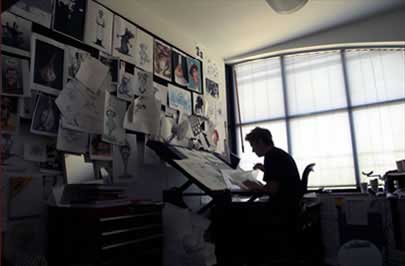
Believable acting means that the audience feels that the character's actions are the result of its own inner motives, and not the animator's inner motives; that the character feels, thinks and reacts consistently according to its personality and mood. I emphasized the last sentence since it encapsulates many of the ingredients of convincing acting:
Feel.
The aim here is not just to portray clear and defined feelings (happy, sad, etc.) but to look for a kind of inner feeling that we have in us all the time - maybe it can be called "consciousness". Try to "feel" your character when you create animation, not just move it around according to the principles of animation.
Think.
Your character shouldn't always act on immediate instincts. Look for opportunities to show thinking process, which leads to decision and action. It will enrich your animation with depth, complexity and believability.
React.
Acting is actually more or less a series of reactions - the character reacts to its environment, to other characters, to stimulus. Every action must have a reason. Make sure you know what your character is reacting to, and that the reaction is reasonable (in other words: it's reasonable that this particular character will react in this particular way).
Consistency.
Retain a consistent attitude to your character's reactions. A shy character (small, timid movements) that unexpectedly acts in an extroverted way with no clear reason, will suffer great damage to its credibility.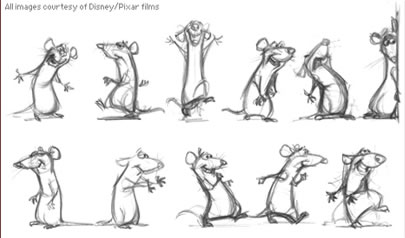
Personality.
The character's personality dictates its reactions - i.e., its acting. Again, we are not necessarily talking about a definite personality such as "arrogant", "grumpy", etc. Try to get to know your character the way you know a family member or someone you work with. What makes him tick? What is he afraid of? What are his problems?
Mood.
Mood resembles personality - it, too, dictates the character's reactions - but unlike personality, its effect is temporary. For example: a guy who's hurrying to work acts and reacts in a very different way than the very same guy as he calmly walks his dog in the evening.
* * *
Reading the above notions, one might think - "hey, all those things belong to the script and storyboard! Reactions, personality, mood - I can't control that! I'm just the animator here, my job is merely to move the character around and make sure there's a lot of anticipation!". My answer is in the following example:
The storyboard shows a character entering the frame, and looking angrily at another character. You're assigned to the scene, and the questions that should arise are: does the character enter slowly? Quickly? Determinedly? Hesitantly? Does he stop suddenly or gradually? Did he know the other character would be there, or does he spot it in the scene? Is he furious, or merely dissatisfied? What sort of anger is it - helpless (like a child's anger towards his parents), or superior (like a parent's towards his child)? And so on and so forth.
The actor/animator's task is to carefully read the script, study the storyboard, and try to "get into" the character. In other words: to find the character's inner feeling and to "wear" it for a while as if it was his own - so that he can get to know and understand the character. A good actor doesn't invent his acting - he discovers it. And still the animator faces the tough challenge of putting the experience into his animation, keeping the principles of motion. It isn't easy, but the reward - that magical moment of believable animation - is worth the effort.
By Doron A. Meir

In the various internet forums one can find threads concerning software, design, textures - some even talk about movement - but it's rare to read something about acting. I haven't yet seen a comment saying something like "the animation is good, but the character has no personality". It seems that the level of expectations is so low, that it's enough for an animator not to make technical errors. Would you consider praising a writer simply because he made no spelling mistakes?
In the following article I have put on paper my thoughts considering acting in animation, which apply to any form of character animation - including 3D. The article is not meant to provide a "good acting in animation" formula - simply because such a formula does not exist. Every animator has his personal attitude, every film has needs of its own, and undoubtedly there are other ways of getting good acting. The goal is to propose a "toolbox" for the actor/animator, and maybe raise - even a little - the animators' awareness of acting in animation.
What is good acting?
When I ask my students what they think good acting is, the first answer is usually "believable acting". But credibility is only one side of the story. Good acting is believable and interesting. In my opinion, these two attributes wholly define good acting. With this idea as an axiom, we will try to separately analyze what makes acting believable, and what makes it interesting.
I. Believable acting
In the life of an animator there are short and rare moments of true magic. Those moments are the reason I became an animator, and they are the reason I still am one. I'm talking about a moment in which you look at the animation you've just created, and suddenly you believe your own character. Suddenly it's alive, it's there in its own right. Those are the moments of believable acting.
Believable acting holds a great power over the viewers, because the character they're watching gets a sort of meaning. Every man has meaning to us - even if we don't always think about it: If a total stranger sitting next to you on the bus suddenly collapses, you will not be indifferent - because the very fact that he is a flash and blood human earns him that meaning. This is why we feel sorry when Bambi's mother dies: we believe her and we believe Bambi, and both of them mean something to us. On the other hand, the characters in South Park are anything but believable, which is why there's no problem killing Kenny in each chapter.
(This might be the right place to reemphasize that the animator is of course not solely responsible for contributing meaning to the characters - script has an important part in it too. This article, however, is dealing with animation).

Believable acting means that the audience feels that the character's actions are the result of its own inner motives, and not the animator's inner motives; that the character feels, thinks and reacts consistently according to its personality and mood. I emphasized the last sentence since it encapsulates many of the ingredients of convincing acting:
Feel.
The aim here is not just to portray clear and defined feelings (happy, sad, etc.) but to look for a kind of inner feeling that we have in us all the time - maybe it can be called "consciousness". Try to "feel" your character when you create animation, not just move it around according to the principles of animation.
Think.
Your character shouldn't always act on immediate instincts. Look for opportunities to show thinking process, which leads to decision and action. It will enrich your animation with depth, complexity and believability.
React.
Acting is actually more or less a series of reactions - the character reacts to its environment, to other characters, to stimulus. Every action must have a reason. Make sure you know what your character is reacting to, and that the reaction is reasonable (in other words: it's reasonable that this particular character will react in this particular way).
Consistency.
Retain a consistent attitude to your character's reactions. A shy character (small, timid movements) that unexpectedly acts in an extroverted way with no clear reason, will suffer great damage to its credibility.

Personality.
The character's personality dictates its reactions - i.e., its acting. Again, we are not necessarily talking about a definite personality such as "arrogant", "grumpy", etc. Try to get to know your character the way you know a family member or someone you work with. What makes him tick? What is he afraid of? What are his problems?
Mood.
Mood resembles personality - it, too, dictates the character's reactions - but unlike personality, its effect is temporary. For example: a guy who's hurrying to work acts and reacts in a very different way than the very same guy as he calmly walks his dog in the evening.
* * *
Reading the above notions, one might think - "hey, all those things belong to the script and storyboard! Reactions, personality, mood - I can't control that! I'm just the animator here, my job is merely to move the character around and make sure there's a lot of anticipation!". My answer is in the following example:
The storyboard shows a character entering the frame, and looking angrily at another character. You're assigned to the scene, and the questions that should arise are: does the character enter slowly? Quickly? Determinedly? Hesitantly? Does he stop suddenly or gradually? Did he know the other character would be there, or does he spot it in the scene? Is he furious, or merely dissatisfied? What sort of anger is it - helpless (like a child's anger towards his parents), or superior (like a parent's towards his child)? And so on and so forth.
The actor/animator's task is to carefully read the script, study the storyboard, and try to "get into" the character. In other words: to find the character's inner feeling and to "wear" it for a while as if it was his own - so that he can get to know and understand the character. A good actor doesn't invent his acting - he discovers it. And still the animator faces the tough challenge of putting the experience into his animation, keeping the principles of motion. It isn't easy, but the reward - that magical moment of believable animation - is worth the effort.
By Doron A. Meir
Wednesday, May 25, 2011
A WALK ON THE ANIMATION
Animating a walk can be a challenge for any animator. They become much easier when we keep in mind a few important elements, such as: EMOTION, WEIGHT, and strong KEY POSES. Of course these ingredients are important to any form of animation - 2D or 3D.
The element we begin with is EMOTION, Ask yourself... WHO IS YOUR CHARACTER?...WHAT IS HE, SHE OR IT'S EMOTIONAL STATE OF MIND?... WHERE ARE THEY GOING?...WHERE ARE THEY COMING FROM?...AND WHY?
EMOTION affects EVERY aspect of the walk.
The GREATER the emotional weight...the GREATER the physical weight.
An ANGRY walk should be forceful and have more weight.. A SAD or DEPRESSED walk will display more weight but be more sluggish and seem closer to the ground. During a HAPPY or JOYOUS walk the character will seem lighter and his movements freer and further from the ground. Knowing the EMOTION of the character is the first step of any walk.

Some examples of EMOTIONS. (Note the WEIGHT differences)
WEIGHT is the next ingredient of a walk! Again, THE GREATER THE EMOTIONAL WEIGHT...THE GREATER PHYSICAL WEIGHT

WEIGHT can be shown in the FEET...LEGS and BODY. Specifically, SQUASHING the FEET, the QUADRICEPS and the BELLY can add greater weight to the character. Having the "weight of the world" on his shoulders can be shown physically.

Once the ideas of EMOTION and WEIGHT are thought out we add STRONG POSING... which means THUMBNAILS!

To better understand the movement...let's begin with the PRIMARY ACTION of the HIPS , LEGS and FEET.
| The first pose is the CONTACT position. Feel free to indicate the hips and to designate the left foot and the right foot. Note: The HEEL of the LEFT foot and the TOE of the RIGHT foot make contact. The CONTACT postion measures of the stride. The left and right feet are in different places on the plane. |  |
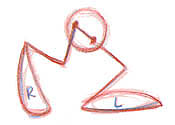 | The next KEY POSE is the RECOIL pose. It works best as the very next drawing of the walk. It is usually the LOWEST pose in the movement. RECOIL pose shows a lot of WEIGHT and IMPACT....especially when it follows the CONTACT pose. |
| Note: During as normal walk, Go from the CONTACT to the RECOIL in one drawing - no inbetweens or it will look mushy Notice the SQUASH (WEIGHT) of the foot... |  |
 | The next pose of the walk is the PASSING POSITION; where one leg passes the other as it advances forward. The PASSING POSITION or POSE can be the highest point of the walk. NOTE: The right hip has rotated upward in an arc. |
IT IS VERY IMPORTANT TO MAKE THE KNEE OF THE PASSING LEG "READ"!!!

| ALWAYS draw a good "READABLE" SILHOUETTE Generally, the PASSING POSE shows the MOST WEIGHT of all the drawings in a walk. Remember, the leg moving forward has separate ARCS for the HIPS, KNEES, ANKLES and TOES. |  |
 | As the leg come forward...you can bring the FOOT forward in one of these two ways. |
The next KEY POSE of the walk is just the reverse of the first CONTACT POSE.

Once the PRIMARY action is KEYED OUT; pencil test the KEYS and check out the movements and timing. Try these timings:

NOTE: The six frames and eight frames indicate the key pose plus two or three inbetween drawings.
| ANOTHER NOTE: Between the CONTACT position and the PASSING postion the character will be ON BALANCE. Between the PASSING position and the next CONTACT drawing the character will be OFF BALANCE. If the character is walking across the fram, the CONTACT measure the length of the STRIDE - the placement of the toes and heels are important. |  |

| Once the PRIMARY action is tested - we can add the torso, a SECONDARY action. Avoid having the torso be too "straight up". The character will become stiff. Lean the torso slightly forward. |  |
 | During the RECOIL position, bring the torso forward. |
| During the PASSING position, you have two options for the torso and spine. REVERSING the spine (a BODY REVERSAL) when the leg extends makes for a more fluid movement. (NOTE: We will cover BODY REVERSALS more in another lesson.) |  |
Next, we add the character's head, another SECONDARY action...
NOTE: You can use OPPOSITE actions to create greater flexibility of the head and neck.

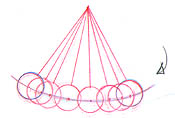 | The last phase of the walk is the SECONDARY action of the arm swing. The arm swing is like a pendulum. The movement is motivated by the SHOULDER....NOT the hand! |
| The shoulders move opposite the hips. When the left arm is forward the left leg is back. When the right arm is back the right leg is forward. |  |
 | NOTE: a Nice OVERLAPPING ACTION can occur by having the arm swing be at it's extreme positon during the "RECOIL" position and not the CONTACT position. Generally, the arm slows in and out at either end of each swing. Don't forget too add the inbetweens and then pencil test. |
Subscribe to:
Posts (Atom)











































